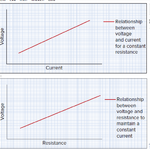brownt
Member level 3

Follow along with the video below to see how to install our site as a web app on your home screen.
Note: This feature may not be available in some browsers.





I understand the relationship between V, I and R in written terms as in proportionality and the inverse. But I can't see how the graph relates. Can someone explain it please.


